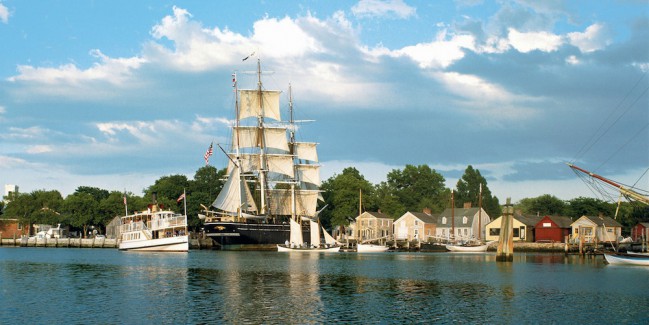A legendary maritime destination – for more than 300 years.
Long before Mystic Seaport Museum’s ships, shops and shipyard, the banks of the Mystic River were filled with…ships, shops, and shipyards. Since the 1600s, this historic area has been a center of shipbuilding. Between 1784 and 1919–the golden age of American maritime enterprise–more than 600 vessels were constructed along the Mystic River. But with the advent of steam power and the decline of wooden shipbuilding after the Civil War, textile manufacturing became Mystic’s dominant industry.
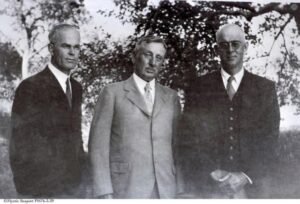
Big dreams during the Great Depression.
As the great Age of Sail gave way to steamships and railroads, wooden ships and boats were turned into firewood and the nation’s seafaring traditions began to disappear, three Mystic residents decided to work together to keep the past alive.
On December 25, 1929, Edward E. Bradley, an industrialist; Carl C. Cutler, a lawyer; and Dr. Charles K. Stillman, a physician; signed the papers incorporating the Marine Historical Association, today known as Mystic Seaport Museum. Their dream: create a dynamic, educational institution to preserve America’s maritime culture–and turn the achievements of a past era into an inspirational force for the future.
Time to get growing.
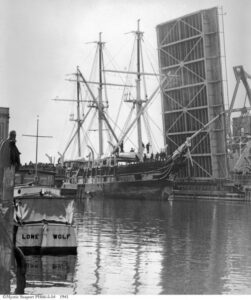
Despite the economic conditions of the Great Depression, Mystic Seaport Museum grew rapidly. Donations of log books, photography, ships plans and other maritime artifacts poured into the one-building museum. In 1941, Mystic Seaport acquired the Charles W. Morgan, the country’s last wooden whaleship from the once-great Yankee fleet. Historic buildings from across New England were also moved in to complement the Morgan–and the authentic coastal village area of Mystic Seaport Museum was born.
Over the next 50 years, the Museum experienced explosive growth, amassing the world’s largest collections of maritime photography (more than 1 million images) and boats (more than 525), as well as collecting two million other maritime artifacts. And the 1970s saw the creation of the Henry B. duPont Preservation Shipyard, additional exhibition buildings, and several new accredited educational programs.
Mystic Seaport Museum reaches its goals. Then, sets new ones.
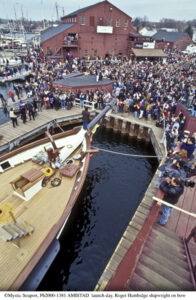
By the 1990s, Mystic Seaport was widely recognized as the nation’s leading maritime museum. In 1996, Mystic Seaport underscored its mission to create a broad public understanding of the relationship of America and the sea with a six-week seminar entitled America and the Sea, which encouraged college professors from around the country to incorporate maritime history into their teachings.
In 1998, Mystic Seaport began construction of the freedom schooner Amistad–marking a major educational program centered on the re-creation of an historic vessel from the keel up. In 2000, the Museum published its 70th publication, America and the Sea: A Maritime History, described by Kirkus Reviews as “the definitive work on the subject.” And in the summer of 2000, the dramatic exhibit Voyages: Stories of America and the Sea opened to national acclaim.
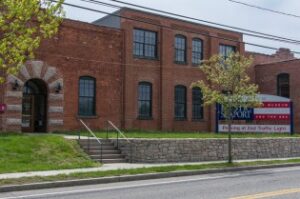
Now, Mystic Seaport Museum is making the history of America’s relationship with the sea even more accessible to all-new audiences. As part of a an extensive expansion plan that includes new exhibit halls and reception areas, the Museum’s state-of-the-art Collections Research Center provides easy and convenient ways for scholars and researchers from around the world to access Mystic Seaport Museum’s renowned archives, via the Internet and integrated databases. It’s just one of many ways this showcase of the past two centuries is preparing for the next one.
A 38th Voyage
After an extensive restoration that began in 2008, the Museum sailed the Charles W. Morgan on a ceremonial 38th Voyage (the ship sailed 37 voyages as an active whaleship). The route took the vessel from Mystic and New Londong to Newport, Martha’s Vineyard, New Bedford , Provincetown, and Boston, where the ship was berthed next to USS Constitution, the only American ship older than the Morgan. Along the way more than 68,000 people visited the ship.
A New Era of Exhibitions
On September 24, 2016, Mystic Seaport celebrated the opening of the Thompson Exhibition Building, an event that completed a transformation of the north end of the Museum grounds. The Thompson Building is the cornerstone and final element of the McGraw Gallery Quadrangle, which integrates existing buildings and grounds with new construction and unifies the components of that portion of the Museum by focusing on their common role as formal exhibition galleries.
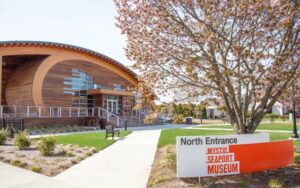
The 14,000-square-foot building houses the Collins Gallery, a 5,000-square-foot hall featuring soaring ceilings and a flexible layout to accommodate objects of varying size and installations of all types. This is the largest among the Museum’s seven formal galleries and will provide the caliber of conditions required to curate not only exhibits from the Mystic Seaport Museum collections, but also permit the borrowing of outstanding art and artifacts from other museums around the world.
“The opening of the Thompson Exhibition Building is the culmination of many years of work and the fulfillment of a vision to focus on the display of our collections in ways we have never been able to do before,” said Steve White, president of Mystic Seaport Museum. “This increase in our exhibition capacity creates a more robust year-round experience for the visitor, which makes this project not just an investment in the future of Mystic Seaport, but also an investment in the future of tourism for the entire region.”

